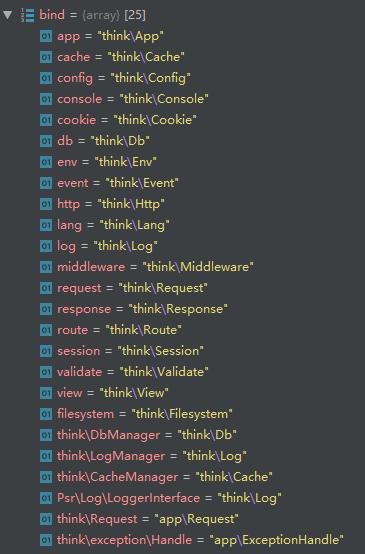[TOC]
# 說明
從這一節開始,我們對一次請求(比如web訪問)的生命周期進行分析,涵蓋框架個核心功能。這一節 分析`App`,`Http` 類的實例化過程,同時了解類是如何實現自動實例化的,即依賴注入是怎么實現的。
# 再次從入口文件出發
當訪問一個ThinkPHP搭建的站點,框架最先是從入口文件開始的,然后才是應用初始化、路由解析、控制器調用和響應輸出等操作。
入口文件主要代碼如下:
```
// 引入自動加載器,實現類的自動加載功能(PSR4標準)
// 具體參見上一節分析
require __DIR__ . '/../vendor/autoload.php';
// 這一句可分為兩部分分析,App的實例化和調用「http」,具體見下文分析
$http = (new App())->http;
$response = $http->run();
$response->send();
$http->end($response);
```
# App實例化
執行 `new App()` 實例化時,首先會調用它的構造函數。
```
public function __construct(string $rootPath = '')
{
// thinkPath目錄:如,D:\dev\tp6\vendor\topthink\framework\src\
$this->thinkPath = dirname(__DIR__) . DIRECTORY_SEPARATOR;
// 項目根目錄,如:D:\dev\tp6\
$this->rootPath = $rootPath ? rtrim($rootPath, DIRECTORY_SEPARATOR) . DIRECTORY_SEPARATOR : $this->getDefaultRootPath();
$this->appPath = $this->rootPath . 'app' . DIRECTORY_SEPARATOR;
$this->runtimePath = $this->rootPath . 'runtime' . DIRECTORY_SEPARATOR;
// 如果存在服務提供者文件
if (is_file($this->appPath . 'provider.php')) {
// 將文件里的所有映射合并到容器的「$bind」成員變量中
$this->bind(include $this->appPath . 'provider.php');
}
// 將當前容器實例保存到成員變量「$instance」中,也就是容器自己保存自己的一個實例
static::setInstance($this);
// 保存綁定的實例到「$instances」數組中,見對應分析
$this->instance('app', $this);
$this->instance('think\Container', $this);
}
```
構造函數實現了項目各種基礎路徑的初始化,并讀取了`provider.php`文件,將其類的綁定并入`$bind`成員變量,`provider.php`文件默認內容如下:
```
return [
'think\Request' => Request::class,
'think\exception\Handle' => ExceptionHandle::class,
];
```
合并后,`$bind`成員變量的值如下:

`$bind`的值是一組類的標識到類的映射。從這個實現也可以看出,**我們不僅可以在`provider.php`文件中添加標識到類的映射,而且可以覆蓋其原有的映射,也就是將某些核心類替換成自己定義的類**。
## `static::setInstance($this)`實現的作用
如圖所示:

`think\App`類的`$instance`成員變量指向`think\App`類的一個實例,也就是類自己保存自己的一個實例。
## `instance()`方法的實現
```
public function instance(string $abstract, $instance)
{
$abstract = $this->getAlias($abstract);
//保存綁定的實例到「$instances」數組中
//比如,$this->instances["think\App"] = $instance;
$this->instances[$abstract] = $instance;
return $this;
}
```
其中的`getAlias`方法:
```
public function getAlias(string $abstract): string
{
//檢查「$bind」中是否保存了名稱到實際類的映射,如 'app'=> 'think\App'
//也就是說,只要綁定了這種對應關系,通過傳入名稱,就可以找到實際的類
if (isset($this->bind[$abstract])) {
//$abstract = 'app', $bind = "think\App"
$bind = $this->bind[$abstract];
//如果「$bind」是字符串,重走上面的流程
if (is_string($bind)) {
return $this->getAlias($bind);
}
}
return $abstract;
}
```
執行結果大概是這樣的:

# Http類的實例化以及依賴注入原理
這里,`$http = (new App())->http`,前半部分好理解,后半部分乍一看有點讓人摸不著頭腦,`App`類并不存在`http`成員變量,這里何以大膽調用了一個不存在的東東呢?
原來,`App`類繼承自`Container`類,而`Container`類實現了`__get()` 魔術方法,在PHP中,當訪問到的變量不存在,就會觸發`__get()`魔術方法。該方法的實現如下:
```
public function __get($name)
{
return $this->get($name);
}
```
實際上是調用`get()`方法:
```
public function get($abstract)
{
//先檢查是否有綁定實際的類或者是否實例已存在
//比如,$abstract = 'http'
if ($this->has($abstract)) {
return $this->make($abstract);
}
// 找不到類則拋出類找不到的錯誤
throw new ClassNotFoundException('class not exists: ' . $abstract, $abstract);
}
```
然而,實際上,主要是`make()`方法:
```
public function make(string $abstract, array $vars = [], bool $newInstance = false)
{
$abstract = $this->getAlias($abstract);
//如果已經存在實例,且不強制創建新的實例,直接返回已存在的實例
if (isset($this->instances[$abstract]) && !$newInstance) {
return $this->instances[$abstract];
}
//如果有綁定,且綁定的是閉包
if (isset($this->bind[$abstract]) && $this->bind[$abstract] instanceof Closure) {
//通過反射實執行方法
$object = $this->invokeFunction($this->bind[$abstract], $vars);
} else {
//通過反射實例化需要的類,比如'think\Http'
$object = $this->invokeClass($abstract, $vars);
}
if (!$newInstance) {
$this->instances[$abstract] = $object;
}
return $object;
}
```
然而,`make()`方法主要靠`invokeClass()`來實現類的實例化(如果綁定的是閉包的話,則靠invokeFunction方法)。該方法具體分析:
```
public function invokeClass(string $class, array $vars = [])
{
try {
//通過反射實例化類
$reflect = new ReflectionClass($class);
} catch (ReflectionException $e) {
throw new ClassNotFoundException('class not exists: ' . $class, $class, $e);
}
if ($reflect->hasMethod('__make')) {
//返回的$method包含'__make'的各種信息,如公有/私有
$method = $reflect->getMethod('__make');
//檢查是否是公有方法且是靜態方法
if ($method->isPublic() && $method->isStatic()) {
//綁定參數
$args = $this->bindParams($method, $vars);
//調用該方法(__make),因為是靜態的,所以第一個參數是null
//因此,可得知,一個類中,如果有__make方法,在類實例化之前會首先被調用
return $method->invokeArgs(null, $args);
}
}
//獲取類的構造函數
$constructor = $reflect->getConstructor();
//有構造函數則綁定其參數
$args = $constructor ? $this->bindParams($constructor, $vars) : [];
//根據傳入的參數,通過反射,實例化類
$object = $reflect->newInstanceArgs($args);
// 執行容器回調
$this->invokeAfter($class, $object);
return $object;
}
```
以上代碼可看出,在一個類中,添加`__make()`方法,在類實例化時,會最先被調用。以上最值得一提的是`bindParams()`方法:
```
protected function bindParams(ReflectionFunctionAbstract $reflect, array $vars = []): array
{
//如果參數個數為0,直接返回
if ($reflect->getNumberOfParameters() == 0) {
return [];
}
// 判斷數組類型 數字數組時按順序綁定參數
reset($vars);
$type = key($vars) === 0 ? 1 : 0;
//通過反射獲取函數的參數,比如,獲取Http類構造函數的參數,為「App $app」
$params = $reflect->getParameters();
$args = [];
foreach ($params as $param) {
$name = $param->getName();
$lowerName = self::parseName($name);
$class = $param->getClass();
//如果參數是一個類
if ($class) {
//將類型提示的參數實例化
$args[] = $this->getObjectParam($class->getName(), $vars);
// 如果參數是普通數組
} elseif (1 == $type && !empty($vars)) {
$args[] = array_shift($vars);
// 如果參數是關聯數組
} elseif (0 == $type && isset($vars[$name])) {
$args[] = $vars[$name];
} elseif (0 == $type && isset($vars[$lowerName])) {
$args[] = $vars[$lowerName];
// 如果參數有默認值
} elseif ($param->isDefaultValueAvailable()) {
$args[] = $param->getDefaultValue();
} else {
throw new InvalidArgumentException('method param miss:' . $name);
}
}
return $args;
}
```
而這之中,又最值得一提的是`getObjectParam()`方法:
```
protected function getObjectParam(string $className, array &$vars)
{
$array = $vars;
$value = array_shift($array);
// 如果傳入的值已經是一個實例,直接返回
if ($value instanceof $className) {
$result = $value;
array_shift($vars);
} else {
//實例化傳入的類
$result = $this->make($className);
}
return $result;
}
```
`getObjectParam()`方法再一次光榮地調用`make()`方法,實例化一個類,而這個類,正是從`Http`的構造函數提取的參數,而這個參數又恰恰是一個類的實例——`App`類的實例。到這里,程序不僅通過PHP的反射類實例化了`Http`類,而且實例化了`Http`類的依賴`App`類。假如`App`類又依賴`C`類,`C`類又依賴`D類`……不管多少層,整個依賴鏈條依賴的類都可以實現實例化。
總的來說,整個過程大概是這樣的:需要實例化`Http`類 ==> 提取構造函數發現其依賴`App`類 ==> 開始實例化`App`類(如果發現還有依賴,則一直提取下去,直到天荒地老)==> 將實例化好的依賴(App類的實例)傳入`Http`類來實例化`Http`類。
這個過程,起個裝逼的名字就叫做「依賴注入」,起個摸不著頭腦的名字,就叫做「控制反轉」。
這個過程,如果退回遠古時代,要實例化`Http`類,大概是這樣實現的(假如有很多層依賴):
```
.
.
.
$e = new E();
$d = new D($e);
$c = new C($d);
$app = new App($c);
$http = new Http($app);
.
.
.
```
這得有多累人。而現代PHP,交給「容器」就好了。
另外,需要提的一點是`make`方法的` $vars`參數,它的形式可以是普通數組、關聯數組,而且數組中元素的值可以是一個類的實例。` $vars`參數的值最終將傳遞給要實例化的類的構造函數或者`__make`方法中對應的參數。
